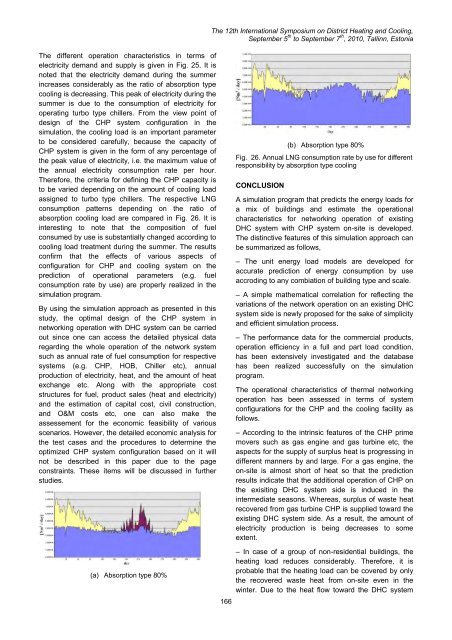12th International Symposium on District Heating and Cooling
12th International Symposium on District Heating and Cooling
12th International Symposium on District Heating and Cooling
You also want an ePaper? Increase the reach of your titles
YUMPU automatically turns print PDFs into web optimized ePapers that Google loves.
The <str<strong>on</strong>g>12th</str<strong>on</strong>g> <str<strong>on</strong>g>Internati<strong>on</strong>al</str<strong>on</strong>g> <str<strong>on</strong>g>Symposium</str<strong>on</strong>g> <strong>on</strong> <strong>District</strong> <strong>Heating</strong> <strong>and</strong> <strong>Cooling</strong>,September 5 th to September 7 th , 2010, Tallinn, Est<strong>on</strong>iaThe different operati<strong>on</strong> characteristics in terms ofelectricity dem<strong>and</strong> <strong>and</strong> supply is given in Fig. 25. It isnoted that the electricity dem<strong>and</strong> during the summerincreases c<strong>on</strong>siderably as the ratio of absorpti<strong>on</strong> typecooling is decreasing. This peak of electricity during thesummer is due to the c<strong>on</strong>sumpti<strong>on</strong> of electricity foroperating turbo type chillers. From the view point ofdesign of the CHP system c<strong>on</strong>figurati<strong>on</strong> in thesimulati<strong>on</strong>, the cooling load is an important parameterto be c<strong>on</strong>sidered carefully, because the capacity ofCHP system is given in the form of any percentage ofthe peak value of electricity, i.e. the maximum value ofthe annual electricity c<strong>on</strong>sumpti<strong>on</strong> rate per hour.Therefore, the criteria for defining the CHP capacity isto be varied depending <strong>on</strong> the amount of cooling loadassigned to turbo type chillers. The respective LNGc<strong>on</strong>sumpti<strong>on</strong> patterns depending <strong>on</strong> the ratio ofabsorpti<strong>on</strong> cooling load are compared in Fig. 26. It isinteresting to note that the compositi<strong>on</strong> of fuelc<strong>on</strong>sumed by use is substantially changed according tocooling load treatment during the summer. The resultsc<strong>on</strong>firm that the effects of various aspects ofc<strong>on</strong>figurati<strong>on</strong> for CHP <strong>and</strong> cooling system <strong>on</strong> thepredicti<strong>on</strong> of operati<strong>on</strong>al parameters (e.g. fuelc<strong>on</strong>sumpti<strong>on</strong> rate by use) are properly realized in thesimulati<strong>on</strong> program.By using the simulati<strong>on</strong> approach as presented in thisstudy, the optimal design of the CHP system innetworking operati<strong>on</strong> with DHC system can be carriedout since <strong>on</strong>e can access the detailed physical dataregarding the whole operati<strong>on</strong> of the network systemsuch as annual rate of fuel c<strong>on</strong>sumpti<strong>on</strong> for respectivesystems (e.g. CHP, HOB, Chiller etc), annualproducti<strong>on</strong> of electricity, heat, <strong>and</strong> the amount of heatexchange etc. Al<strong>on</strong>g with the appropriate coststructures for fuel, product sales (heat <strong>and</strong> electricity)<strong>and</strong> the estimati<strong>on</strong> of capital cost, civil c<strong>on</strong>structi<strong>on</strong>,<strong>and</strong> O&M costs etc, <strong>on</strong>e can also make theassessement for the ec<strong>on</strong>omic feasibility of variousscenarios. However, the detailed ec<strong>on</strong>omic analysis forthe test cases <strong>and</strong> the procedures to determine theoptimized CHP system c<strong>on</strong>figurati<strong>on</strong> based <strong>on</strong> it willnot be described in this paper due to the pagec<strong>on</strong>straints. These ítems will be discussed in furtherstudies.(a) Absorpti<strong>on</strong> type 80%166(b) Absorpti<strong>on</strong> type 80%Fig. 26. Annual LNG c<strong>on</strong>sumpti<strong>on</strong> rate by use for differentresp<strong>on</strong>sibility by absorpti<strong>on</strong> type coolingCONCLUSIONA simulati<strong>on</strong> program that predicts the energy loads fora mix of buildings <strong>and</strong> estimate the operati<strong>on</strong>alcharacteristics for networking operati<strong>on</strong> of existingDHC system with CHP system <strong>on</strong>-site is developed.The distinctive features of this simulati<strong>on</strong> approach canbe summarized as follows,– The unit energy load models are developed foraccurate predicti<strong>on</strong> of energy c<strong>on</strong>sumpti<strong>on</strong> by useaccroding to any combiati<strong>on</strong> of building type <strong>and</strong> scale.– A simple mathematical correlati<strong>on</strong> for reflecting thevariati<strong>on</strong>s of the network operati<strong>on</strong> <strong>on</strong> an existing DHCsystem side is newly proposed for the sake of simplicity<strong>and</strong> efficient simulati<strong>on</strong> process.– The performance data for the commercial products,operati<strong>on</strong> efficiency in a full <strong>and</strong> part load c<strong>on</strong>diti<strong>on</strong>,has been extensively investigated <strong>and</strong> the databasehas been realized successfully <strong>on</strong> the simulati<strong>on</strong>program.The operati<strong>on</strong>al characteristics of thermal networkingoperati<strong>on</strong> has been assessed in terms of systemc<strong>on</strong>figurati<strong>on</strong>s for the CHP <strong>and</strong> the cooling facility asfollows.– According to the intrinsic features of the CHP primemovers such as gas engine <strong>and</strong> gas turbine etc, theaspects for the supply of surplus heat is progressing indifferent manners by <strong>and</strong> large. For a gas engine, the<strong>on</strong>-site is almost short of heat so that the predicti<strong>on</strong>results indicate that the additi<strong>on</strong>al operati<strong>on</strong> of CHP <strong>on</strong>the exisiting DHC system side is induced in theintermediate seas<strong>on</strong>s. Whereas, surplus of waste heatrecovered from gas turbine CHP is supplied toward theexisting DHC system side. As a result, the amount ofelectricity producti<strong>on</strong> is being decreases to someextent.– In case of a group of n<strong>on</strong>-residential buildings, theheating load reduces c<strong>on</strong>siderably. Therefore, it isprobable that the heating load can be covered by <strong>on</strong>lythe recovered waste heat from <strong>on</strong>-site even in thewinter. Due to the heat flow toward the DHC system
















